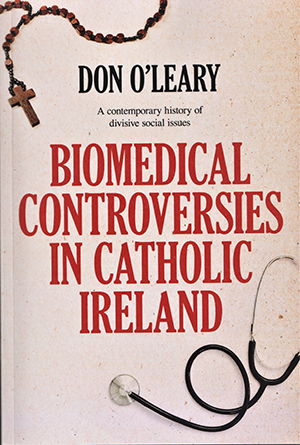BIOMEDICAL CONTROVERSARIES IN CATHOLIC IRELAND
Published in Book Reviews, Book Reviews, Issue 1 (January/February 2021), Volume 29DON O’LEARY
Eryn Press
€18.99
ISBN 9781788461641
Reviewed by Peter Boylan
Peter Boylan is a former Master of the National Maternity Hospital, Dublin.
 Don O’Leary examines a range of contentious issues, from contraception and abortion to human embryonic stem cell research and assisted suicide, which have been, and continue to be, controversial. The focus of the study is the period between Pope Paul VI’s Humanae Vitae encyclical of 1968 and the referendum to repeal the Eighth Amendment 50 years later in 2018. Nine of the ten chapters, as well as an appendix on abortion and infanticide, deal with reproductive medicine.
Don O’Leary examines a range of contentious issues, from contraception and abortion to human embryonic stem cell research and assisted suicide, which have been, and continue to be, controversial. The focus of the study is the period between Pope Paul VI’s Humanae Vitae encyclical of 1968 and the referendum to repeal the Eighth Amendment 50 years later in 2018. Nine of the ten chapters, as well as an appendix on abortion and infanticide, deal with reproductive medicine.
O’Leary details how Catholic Church involvement in education, health and social welfare services has given the Church enormous power in matters of public policy. That that remains a reality today is made clear in his discussion of two live issues: the ongoing controversy relating to the future of the National Maternity Hospital (NMH) and recent moves to table a bill in the Oireachtas on assisted suicide.
O’Leary notes how plans to relocate the NMH to St Vincent’s Hospital in Elm Park sparked a public outcry in April 2017, ‘not only because a hospital built at taxpayers’ expense would be privately owned, but also because some services, such as tubal ligations and vasectomies, would not be provided because of Catholic teaching on sexual morality’. Since the repeal of the Eighth Amendment a year later, these concerns include abortion. He rightly observes that, while in the past numerous hospitals and schools have been built by the State on Church lands and were owned by the Church or its orders, ‘goodwill and trust’ from the public was markedly absent in the NMH controversy for reasons including that ‘the historical legacy of the Religious Sisters of Charity was tainted by the scandalous abuse and exploitation of women in the Magdalene laundries … [and] exacerbated by the refusal of [the Sisters] … to contribute to a redress scheme for several hundred survivors’.
Every hospital built on land owned by the Catholic Church must adhere to Catholic ethical teaching and there is not a single exception anywhere in the world. Over the past three years successive governments, the Department of Health, the Religious Sisters of Charity and St Vincent’s have continued with convoluted discussions on lease arrangements, liens and shareholding transfer to try to resolve the mess. O’Leary notes that even now ‘Issues concerning ownership and governance of the NMH still [need] to be resolved’. How right he is. The Sisters intend to transfer their 100% shareholding of St Vincent’s Healthcare Group into a new company called St Vincent’s Holdings, which will own the NMH outright. But, as O’Leary asks, who will own St Vincent’s Holdings? The company’s constitution (published only after the completion of this book) rings serious alarm bells given that it incorporates in full the core ethical values of the Sisters of Charity. Furthermore, the question remains of the acceptability of the State funding a maternity hospital that will cost at least €500m and then handing it over to a private company. This is one controversy that has yet to be resolved.
Another timely chapter relates to assisted suicide. O’Leary details the legal background to the case of Marie Fleming, who in 2012 unsuccessfully challenged the blanket ban on assisted suicide in both the High Court and in a later appeal to the Supreme Court. In its judgement, the Supreme Court found that Ms Fleming’s constitutional rights had not been violated and noted that it was open to the Oireachtas to legislate for similar cases. The High Court suggested that the Director of Public Prosecutions would act in a ‘humane and sensitive’ way in deciding whether or not to prosecute in similar cases. This did not prove to be the case, however, when Gail O’Rorke was prosecuted three years later for assisting a female friend to take her own life.
Overall, this book makes a valuable addition to the history of the relationship between Church and State in Ireland in the provision of health care, particularly as it relates to reproductive health. I differ in one respect with a key conclusion made by O’Leary. He suggests that ‘legislation and social change in the Republic of Ireland will be mainly determined by Catholic opinion for many years to come’. While I agree with this proposition (in the absence of comprehensive reform of the health care and educational systems), I do not share his assessment that the primary basis for this conclusion is that 80% of the population declared themselves Catholic in the 2016 census. This is at odds with the outcomes of the two most recent referendums on marriage equality and abortion, following which it seems that a majority of Irish Catholics are largely ignoring their Church’s teaching. I suggest instead that there will be a quieter and more insidious influence on public policy emanating from the fact that a significant percentage of the Irish health care system remains in Catholic ownership and will do so likely in perpetuity. Largely unnoticed by the Irish public, Catholic congregations with aging members have been quietly divesting their shareholdings in some of our largest State-funded hospitals into alternative sponsorship arrangements, which are accountable directly to the Vatican. The consequences of this will become apparent over the coming decades.
















